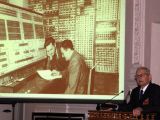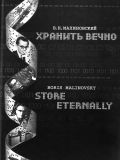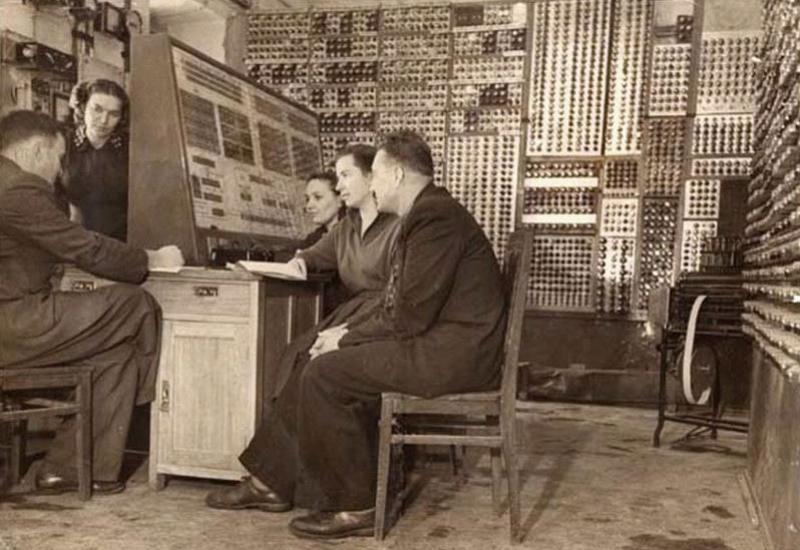On March 19 there was a scientific session of the Scientific Council of NTUU "KPI", where a corresponding member of NAS of Ukraine Borys Malynovskyi, who worked more than half a century in the field of computer science and technology, and in recent years has engaged in the history of home computer engineering, made a report.
The report dealt with the unique thirty years when the computer science and engineering and great engineering staff (mostly of KPI) appeared from scratch. There was created a number of research institutes and engineering departments, factories that began to produce computers. This period - the fifties, sixties and seventies - is a period of rapid development of computer engineering, "the heroic time", according to V. Hlushkov.
 It all started with the first in the USSR and in continental Europe digital counting machine MESM, which was created in the USSR Academy of Sciences under the direction of Lebedev in 1951. and operated until 1956
It all started with the first in the USSR and in continental Europe digital counting machine MESM, which was created in the USSR Academy of Sciences under the direction of Lebedev in 1951. and operated until 1956
In the next 25 years in Ukraine was revealed Viktor Hlushkov's talent. In a short time, just in a few years, Hlushkov created a unique Institute of Cybernetics of AS USSR, where the work was carried out both in development of fundamental theoretical foundations of cybernetics and computer engineering and applied research: development of computers for use in intelligent area (for scientific and engineering calculations), system control of various processes and objects of industrial automation and scientific experiments, military complexes. A third part of computing technique, which was produced in the USSR, was developed in Kiev Institute of Cybernetics of AS USSR! The Institute gained worldwide fame due to its outstanding research and practical results.
An important condition for rapid development of computer engineering in 50 - 70-ies was high material support of research works. In 70-ies, for example, USSR Academy of Sciences budget was about 1 billion rubles (1.2 billion dollars). The Academy annually replenished with almost a thousand young professionals.
In the sixties in Severodonetsk Scientific and Production Association "Impulse" of the Ministry of |Instrumentation, Automation and Control Systems of the USSR mass design and production of computers for controlling industrial processes began. In more than ten thousand operating systems that were developed for different sectors of the economy of the Soviet Union, were used fifteen types of control computers of first - third generations developed by Severodonetsk association. These devices were designed mainly by young people, among whom were almost no PhDs, but their level of work was very high.
The control technique was developed in Kyiv scientific-production associations "Quantum" and "Crystal", Kyiv Research Institute of Hydrodevices, Kharkiv Scientific-Production Association "Khartron", Production Association "Radio Kyiv" and others. There were developed three generations of onboard computers for missiles that during the Cold War provided Soviet strategic parity with the United States, computers for surface ships and submarines of Soviet Navy and others. Computer science and industrial were mass-produced at the plant "Electronmash" and Severodonetsk instrument-making plant.
The development of computer engineerinh was inextricably linked with the development of software and algorithm software, which helped to solve almost any problem. Overall computer engineering largely owes to KPI, as most staff were trained here. The fact that Ukraine was provided with brilliant engineering staff, also largely determines the success of the business. Along with prominent leaders S. Lebedev and V. Hlushkov and chief designers of industry organizations in the fifties worked engineers, most of whom were active young people who, despite their age, had a great experience, because they went through the war and restored the country in the postwar years. The war brought them independence, courage and commitment. In addition, the young people had an unquenchable enthusiasm and desire to serve the new science and give it all their life. This made many of our achievements state-of-the-art.
The thirty years of computing filled with interesting hard work and exceptional achievements are described in the book of Borys Malynovskyi, called "To Save Forever." The title is not accidental: it was written on the folder with archival documents that were used to write the book was written. Indeed, the documentary evidence and testimony that can be found in the book are invaluable and deserve to be known by the next generations. Unique photos, stories of renowned experts in information technology who worked at the time, and a rich treasure trove of memories of the author were also used for writing and preparing the book.
 Reading the book, you can see how the idea of creating machines that would take over non-creative mental work and help to manage a wide variety of processes appeared, you can get an idea of what were the efforts to implement this idea and what was the path from the first attempts to create a "thinking" machine to powerful information technology industry. Borys Malynovskyi warmly remembers the names of people whose hands did it all on the pages of his book, properly assessing their talent, dedication and commitment.
Reading the book, you can see how the idea of creating machines that would take over non-creative mental work and help to manage a wide variety of processes appeared, you can get an idea of what were the efforts to implement this idea and what was the path from the first attempts to create a "thinking" machine to powerful information technology industry. Borys Malynovskyi warmly remembers the names of people whose hands did it all on the pages of his book, properly assessing their talent, dedication and commitment.
The book "To Save Forever" is published in Ukrainian, Russian and English, which will allow the widest possible readership to get acquainted with its content.
B. Malynovskyi has answered the questions of the correspondent of "Kyiv Polytechnic".
– Please, describe the current state of the development of cybernetics.
– Viktor Hlushkov once told me, when we were standing near the Institute of Cybernetics, that if the Institute was created now, he would like to call it the Institute of Computer Science. The fact is that cybernetics has split into various separate research areas, the main of which is computer science. However, cybernetics is a huge layer of history, the role of which is crucial.
Unfortunately, in the nineties, it happened that scientific institutions had small financial rations. It was very difficult for applied areas. The best situation occurred for the sections related to programming because they did not require complex equipment and the implementation of their development was simplified.
In the late nineties, I was in London at the International Symposium on Information Technologies, where representatives of many countries talked about the state policy in the field of information technology. I really liked the speech of the representative of India. Then, the potentials of Ukrainian and Indian programmers were at the same level. At the symposium the Government of India has taken several measures, including banning the import of personal computers and giving the professionals the opportunity to get Indian equipment. Soon the Indian domestic programmers have mastered the technique, and domestic manufacturers began to produce equipment that was not inferior to foreign analogues. This deprived India of dependence of foreign corporations. The government also promoted the work of Indian programmers on the world market. Carrying any foreign equipment from abroad was not a problem. For us smuggling even a floppy disk was very difficult. In the end, India was, as they say, an information giant, as our domestic programmers today are doing much less than what is done in India.
However, as Ukraine had to automate business, mail, the pension business, Hlushkov Institute of Cybernetics of NAS of Ukraine received the order as well as financing. Things went better. In addition, the departments associated with programming received foreign grants. So today the Institute of Cybernetics is in good condition, we hope that over time there will happen the same "explosion" as in the fifties – seventies. Recently we have got a cluster supercomputer (the same is available at KPI). It is very good because it provides for new opportunities for work. Unfortunately, Ukraine is lagged in element base, so we can not be worthy opponents in this, but we can buy it in sufficient quantity. Therefore, there is progress now, but there would not be such without heroic thirty years of which I tell on the pages of my book.
– Now it is believed that there was the persecution of cybernetics in the Soviet Union. Did it actually occur?
– Modern journalists like such topics. In fact, there was not much persecution. On the contrary, the government helped to develop the industry, investing huge funds. Someone wrote in the Philosophical Dictionary of 1955 that cybernetics is a bourgeois science, but there were no obstacles for cybernetics. However, the bureaucracy in the USSR and now in Ukraine is very high, which of course prevents from work. The great work that was done in the first decades after the war, shows that cybernetics did not disturb the Soviet state, on the contrary, it was required.

